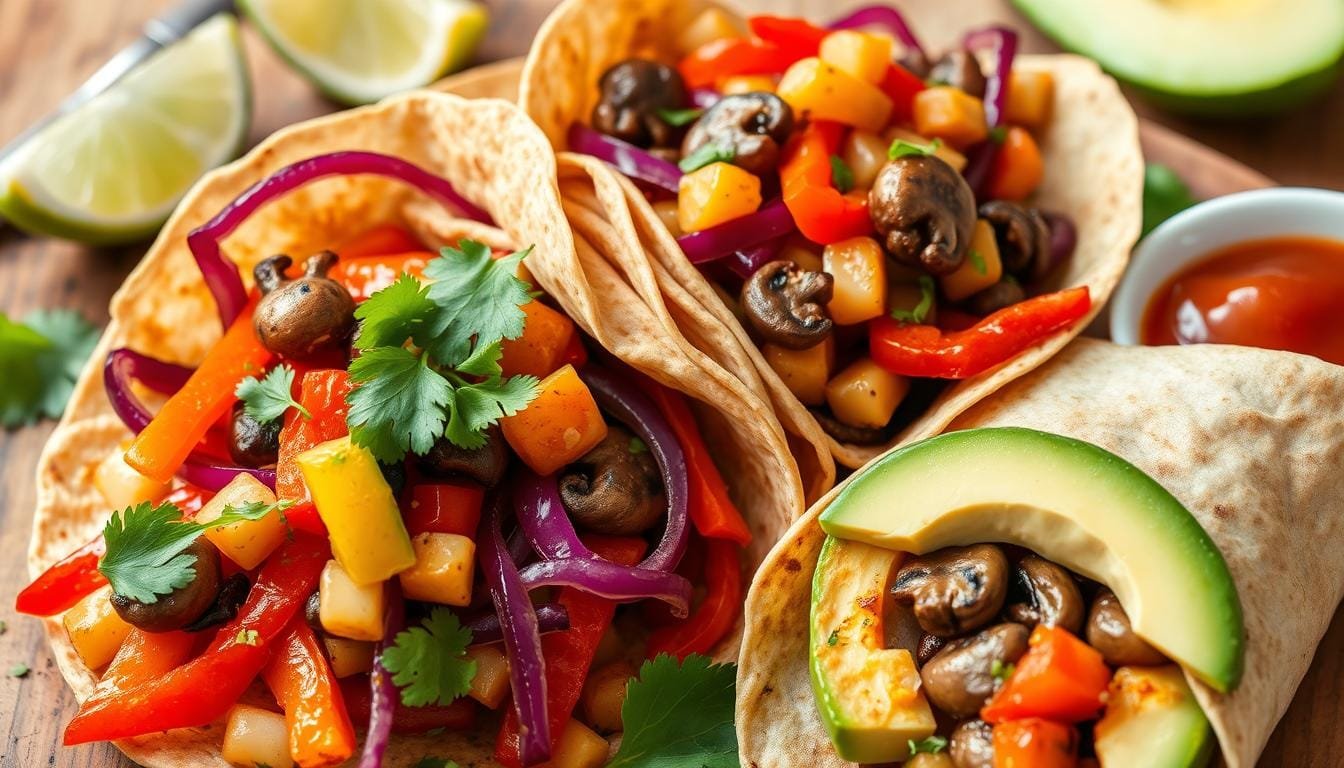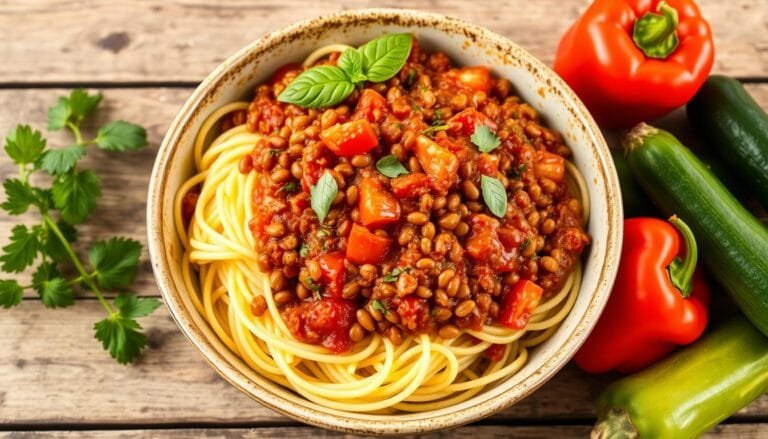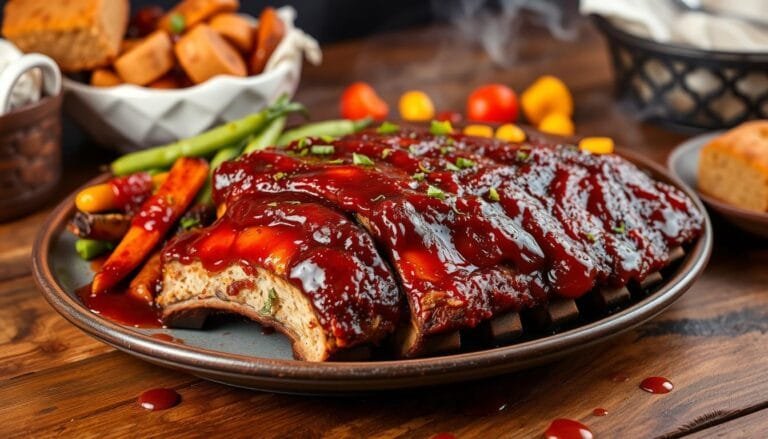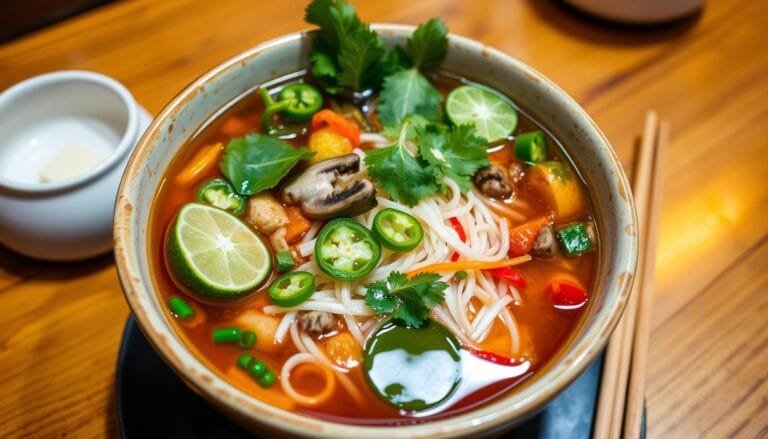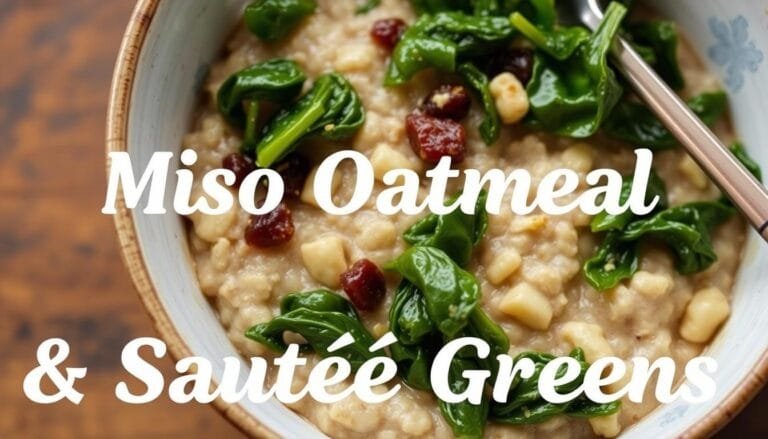I’m a big fan of making plant-based fajita wraps. They’re tasty and good for you. These vegan fajitas are a great vegetarian meal that’s ready in under 30 minutes. They’re perfect for a quick, healthy dinner on a busy night.
They’re filled with colorful bell peppers, onions, and juicy portobello mushrooms. This Mexican-inspired dish is loved by many.
To get the best flavor, cut the veggies into thin strips. This way, they can get nicely charred in the skillet. I use a cast iron skillet for that perfect fajita sear.
Adding fresh lime zest and juice makes the vegan fajitas even more delicious. It’s a simple trick that makes a big difference.
Why I Love Making Plant-Based Fajita Wraps
As a busy parent, I’m always searching for easy weeknight dinner ideas. I want them to be tasty and nutritious vegan recipes. That’s why I love making my own plant-based fajita wraps. They’re full of flavor, good for my health, and quick to make.
Health Benefits of Plant-Based Meals
I love making these wraps because of their health benefits. They’re filled with fiber from veggies like bell peppers and onions. This keeps me full and happy. The soy protein in the filling adds extra nutrition, making it a nutritious vegan recipe.
Time-Saving Kitchen Magic
Time is precious for me as a busy parent. I need recipes that are quick. My plant-based fajita wraps are ready in about 15 minutes before baking. This makes them a great easy weeknight dinner choice. I can do other things while dinner cooks itself.
Budget-Friendly Cooking
Feeding a family can be costly, but my wraps are affordable. Ingredients like bell peppers, onions, and tofu are cheap and easy to find. This nutritious vegan recipe lets me serve a tasty easy weeknight dinner without spending a lot.
| Nutrition Facts | Per Serving |
|---|---|
| Calories | 324 kcal |
| Carbohydrates | 35 g |
| Protein | 15 g |
| Fat | 16 g |
| Sodium | 598 mg |
| Fiber | 8 g |
“The vegan sheet pan fajitas have received a rating of 4.8 out of 5 from 4 votes. The dish is described as bursting with flavor, weeknight-friendly, nutrient-rich, versatile, and an easy recipe.”
Essential Ingredients for Perfect Fajitas
Creating delicious plant-based fajitas requires a few key ingredients. At the center are fajita vegetables like bell peppers, onions, and portobello mushrooms. These add crunch and a smoky flavor.
For protein, I use extra-firm tofu. Its neutral taste lets it soak up the fajita seasoning perfectly. This makes it a hearty and flavorful part of the dish.
The seasoning is the secret to the dish’s success. It’s a mix of chili powder, smoked paprika, cumin, garlic powder, onion powder, and a bit of cayenne. This blend gives the fajitas a bold Tex-Mex flavor.
Lime juice and zest add a fresh, acidic taste. They balance the rich flavors of the dish. These ingredients make a vibrant, satisfying plant-based fajita that’s sure to impress.
| Ingredient | Amount |
|---|---|
| Bell Peppers (red, yellow, orange) | 3 peppers, sliced |
| Onions | 1 large, sliced |
| Portobello Mushrooms | 8 oz, sliced |
| Extra-Firm Tofu | 14 oz, cubed |
| Chili Powder | 2 tsp |
| Smoked Paprika | 1 tsp |
| Cumin | 1 tsp |
| Garlic Powder | 1 tsp |
| Onion Powder | 1 tsp |
| Cayenne Pepper (optional) | 1/4 tsp |
| Sea Salt | 1 tsp |
| Lime Juice | 2 tbsp |
| Lime Zest | 1 tsp |
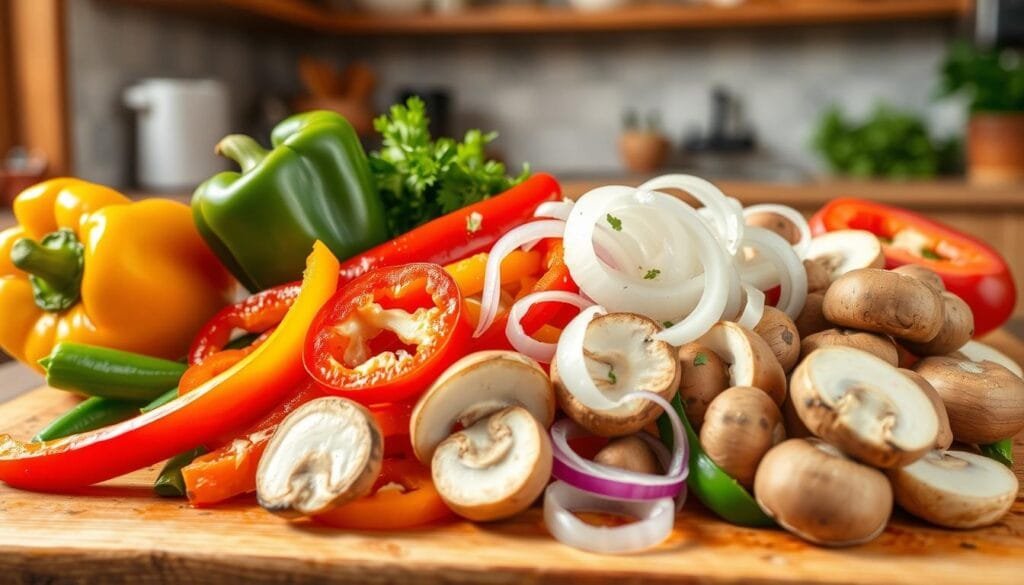
“The key to delicious plant-based fajitas is finding the perfect balance of flavors and textures. With the right combination of vibrant veggies, hearty protein, and spices, you can create a truly satisfying and craveable Tex-Mex experience.”
My Secret Homemade Fajita Seasoning Blend
Creating the perfect plant-based fajita wraps starts with the seasoning. I’ve made a homemade fajita spice blend that adds bold, authentic Mexican flavors. This DIY mix is cheaper than store-bought and lets me adjust the heat to my taste.
Spice Measurements and Ratios
My secret blend includes:
- 1 tablespoon chili powder
- 1/2 tablespoon smoked paprika
- 1/2 tablespoon ground cumin
- 3/4 teaspoon salt
- 1/2 teaspoon onion powder
- 1/2 teaspoon garlic powder
- 1/4 to 1/2 teaspoon cayenne pepper (for customizable heat)
Storage Tips for Fresh Spices
To keep my homemade fajita seasoning fresh, I store it in airtight containers. I keep them away from heat and light. This way, the spices stay flavorful and colorful for up to a year.
Customizing Heat Levels
For a milder flavor, start with 1/4 teaspoon of cayenne pepper. If you like it hotter, use up to 1/2 teaspoon. This blend is very flexible, so you can adjust the heat to your liking.
Choosing the Right Vegetables for Maximum Flavor
Creating the perfect plant-based fajitas starts with picking the right vegetables. A mix of fresh, vibrant veggies is essential for great flavor. I’ve found that choosing the best vegetables for fajitas can make a big difference.
I always begin with a colorful mix of bell peppers – red, yellow, and orange. Their natural sweetness adds a unique flavor. The crisp texture of these colorful peppers also pairs well with other ingredients. Next, I add sliced red onions for a sharp, caramelized taste that balances the dish.
To add more depth, I include meaty portobello mushrooms. Their texture and earthy flavor contrast nicely with the peppers and onions. For a bit of heat, I sometimes add diced jalapeños. This lets everyone adjust the spice to their taste.
| Vegetable | Flavor Profile | Texture |
|---|---|---|
| Bell Peppers (red, yellow, orange) | Sweet | Crisp |
| Red Onions | Sharp, Caramelized | Crunchy |
| Portobello Mushrooms | Earthy, Meaty | Substantial |
| Jalapeños (optional) | Spicy | Crisp |
I always slice the veggies into thin, long strips. This helps them cook evenly and makes them easy to wrap in tortillas. It ensures a delicious fajita experience with every bite.
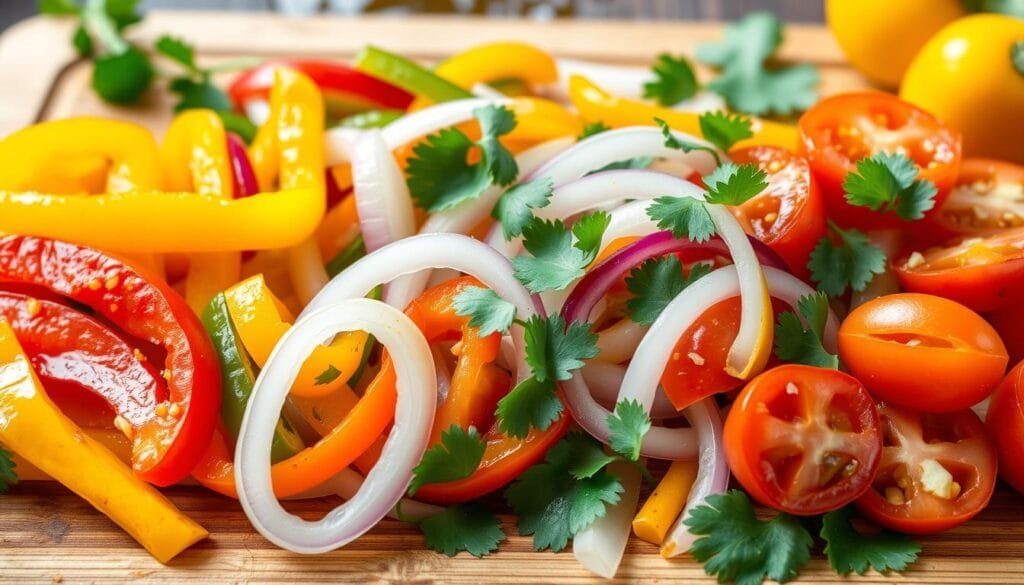
“The key to a truly delicious plant-based fajita is striking the perfect balance of flavors and textures among the fresh vegetables.”
Plant-Based Protein Options for Fajitas
As a vegan, I always look for tasty and healthy protein sources. These include plant-based fajitas, which are a favorite. Extra-firm tofu is a top choice for me. It can be prepared to taste just like chicken fajitas.
Preparing Tofu for Fajitas
To get the right texture, I press and drain the tofu. Then, I cut it into small pieces. This lets it soak up all the fajita seasonings, making it a great vegan fajita protein.
Alternative Protein Sources
Soy curls are another great option for fajitas. They have a meaty texture that’s perfect for fajitas. Tempeh and beans like black or pinto also make tasty tofu fajitas and add protein.
| Protein Source | Preparation | Flavor Profile |
|---|---|---|
| Extra-Firm Tofu | Press, drain, and cut into bite-sized pieces | Mild, absorbs fajita seasonings well |
| Soy Curls | Rehydrate and sauté with fajita spices | Meaty, fibrous texture |
| Tempeh | Slice and marinate in fajita marinade | Nutty, slightly tangy flavor |
| Beans (Black or Pinto) | Sauté with fajita vegetables | Earthy, protein-packed |
Choosing any plant-based protein for fajitas is key. The trick is to let it soak up the fajita flavors well. With a bit of creativity, you can enjoy vegan fajitas just as much as the traditional kind.
Step-by-Step Cooking Instructions
Making tasty vegan fajita wraps is easy and fun. First, heat your oven to 400°F (200°C). Next, lay out chopped veggies and cubed tofu on a big baking sheet. Add a bit of oil and sprinkle with homemade fajita seasoning. Mix well so everything is coated.
Then, let the oven do its thing. Bake for 35-40 minutes, stirring once in the middle. When the veggies are soft and slightly brown, they’re done. Just before you serve, add a squeeze of fresh lime juice for extra flavor.
This whole recipe takes less than 30 minutes. With just 4 steps, you’ll have yummy how to make vegan fajitas ready to wrap in tortillas. It’s a simple and sheet pan fajitas meal everyone will enjoy.

- Preheat oven to 400°F (200°C).
- Spread chopped vegetables and cubed tofu on a baking sheet. Drizzle with oil and sprinkle with fajita seasoning. Toss to coat evenly.
- Bake for 35-40 minutes, stirring halfway, until vegetables are tender and slightly charred.
- Finish with a squeeze of fresh lime juice before serving.
Follow these easy steps for a delicious and healthy batch of how to make vegan fajitas. The secret is letting the oven roast the veggies and tofu perfectly.
Best Tortilla Options and Warming Techniques
Choosing the right tortilla is key to making great fajita wraps. You can pick traditional corn tortillas or soft flour tortillas. Each has its own taste and feel, so it’s up to you.
Corn vs Flour Tortillas
Corn tortillas give a real, earthy flavor that goes well with fajita fillings. They’re also lower in calories and carbs, making them a good choice. Flour tortillas, on the other hand, are softer and more pliable, making them easier to wrap.
Gluten-Free Alternatives
If you’re gluten-free, there are many gluten-free tortillas to choose from. They’re made from corn, rice, or cassava flour. These wraps are tasty and healthy, unlike traditional wheat wraps.
Warming your tortillas right is important for the best texture. You can warm them in a skillet, on a gas burner, or in the oven. This step helps prevent them from cracking or tearing when you fill them with fajita wraps.
| Tortilla Type | Flavor Profile | Texture | Nutritional Benefits |
|---|---|---|---|
| Corn Tortillas | Earthy, authentic | Firm, crisp | Lower in calories and carbs |
| Flour Tortillas | Mild, versatile | Soft, pliable | More calorie-dense |
| Gluten-Free Tortillas | Varies by ingredient | Varies by ingredient | Suitable for gluten-free diets |
For the best fajita wraps, find the right tortilla and warm it well. With a bit of trying, you’ll find your favorite tortilla and warming method. Then, you’ll enjoy making delicious fajita wraps!
Essential Kitchen Tools for Fajita Making
Creating delicious plant-based fajitas is easier with the right tools. A large fajita pan or cast iron skillet is key for the perfect char on veggies and searing protein. For oven cooking, a sheet pan for fajitas ensures even cooking and makes cleanup a breeze.
A sharp knife is vital for cutting veggies evenly. Tongs help toss ingredients for even cooking. And, a citrus juicer is essential for fresh lime juice, adding a zesty flavor to your fajitas.
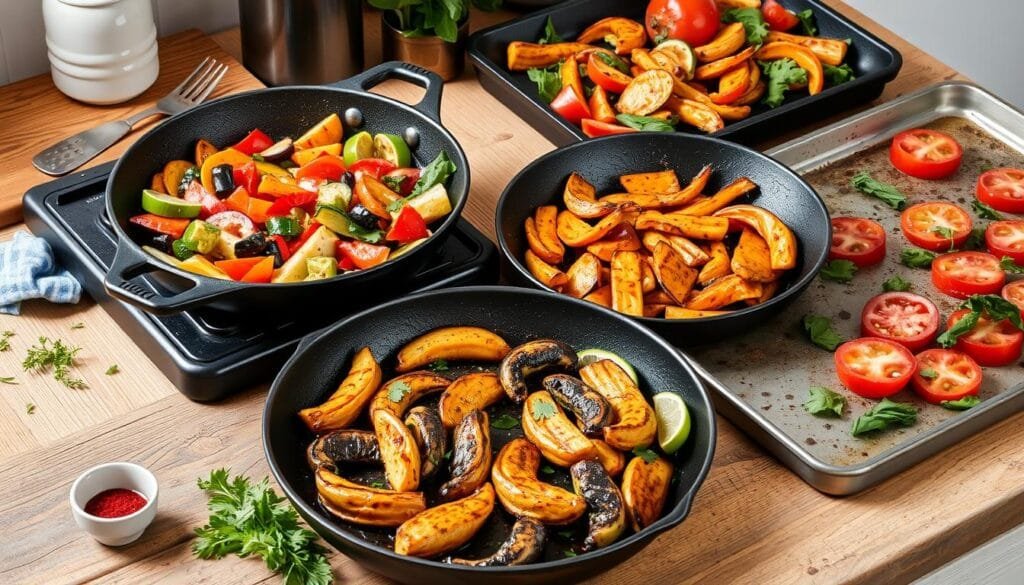
With these tools, you’re ready to make tasty plant-based fajitas. Your taste buds will thank you. Happy cooking!
Creative Toppings and Garnishes
Make your vegan fajita wraps special with tasty toppings and garnishes. Start with creamy avocado for a rich flavor. Add fresh cilantro for a bright, herbal taste that matches the spices well.
For a cool, tangy touch, try vegan sour cream or shredded vegan cheese. Salsa is essential, with its mix of tomatoes, onions, and spices. Make it even better with homemade guacamole, using avocado, lime juice, and garlic.
For crunch, add crisp lettuce, diced tomatoes, or pickled jalapeños. A squeeze of fresh lime juice is key. It balances the richness of the toppings, making all the flavors work together.
Using a mix of these vegan fajita toppings and plant-based garnishes will make your fajitas even more delicious. Try different combinations to find your favorite fajita condiments.
Meal Prep and Storage Solutions
Preparing delicious plant-based fajita wraps is easy. You can keep enjoying them for days with a few tricks. Let’s explore the best ways to store and reheat your fajita leftovers for easy meal prep.
Proper Storage Methods
After cooling, move the cooked veggies and tofu to an airtight container. This keeps them fresh and prevents drying. You can store your fajita mix in the fridge for up to 4 days.
For meal prep, split the fajita fillings into individual containers. This makes reheating a single portion easy. Just remember to use airtight containers for the best freshness.
Reheating Guidelines
Don’t microwave your leftover fajita fillings. Use a dry, hot skillet on the stovetop instead. This keeps the veggies crisp and prevents sogginess.
Heat the fajita mix in the skillet, stirring now and then, until it’s hot and even. This gentle heat ensures your fajitas stay fresh and flavorful.
With these easy storage and reheating tips, you can enjoy fajita meal prep without losing quality. Enjoy your plant-based fajita wraps every day and make the most of your creations!
Serving Suggestions and Pairings
Make your fajita meal even better by adding some tasty sides. Try Mexican rice, creamy refried beans, or a fresh green salad. They add flavor and balance to your dish. For a drink, a homemade lime agua fresca or a pineapple smoothie is perfect.
Set up a fajita bar for a fun dining experience. Let everyone add their favorite toppings and sauces. Offer salsas, guacamole, vegan sour cream, and pickled onions. This way, everyone can make their own special fajita.
Whether you’re hosting a big gathering or a small dinner, these ideas will make your fajitas a hit. Try different sides and recipes to make your meal complete and delicious.
